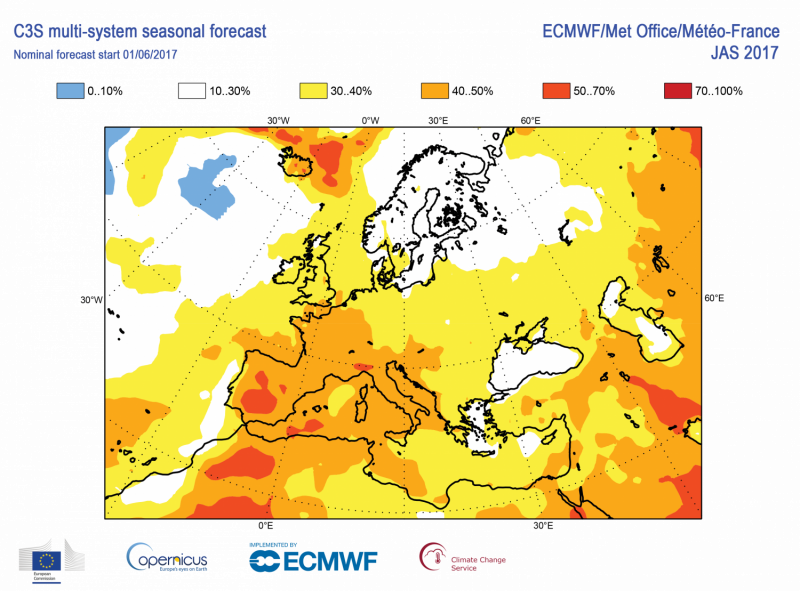Summer heat to test Copernicus programme's prediction service

The ECMWF-run Copernicus Climate Change Service is testing a new service that will make available seasonal forecasts and longer-term climate change predictions of river flow and other hydrological conditions.
With much of Europe having experienced unexpected warmth already this summer, it is natural to ask whether and for how long this heatwave will continue.
The Copernicus Climate Change Service (C3S) contracted the Swedish Meteorological and Hydrological Institute (SMHI) to design a service that would provide climate change indicators and seasonal forecasts for key hydrological variables such as river flow, soil moisture and precipitation. A pre-operational proof-of-concept version is now available at swicca.climate.copernicus.eu/.
A separate C3S contract with the Centre for Ecology & Hydrology (UK) focuses on a complementary system that will similarly provide hydrological information and predictions through a user-friendly web-interface edge.climate.copernicus.eu/
The aim of this combined service for Europe is to provide meaningful information and guidance for climate impact assessments in the water sector. This year could provide a good test of the experimental system, as current conditions suggest much of southern Europe could be heading for a sustained heatwave.
For example, the river Po, which is the largest river in Italy and flows eastwards across the north of the country, was reported to be well below the average levels for this month. The situation has since improved due to the recent rains. Another indication of current drought is that Spanish water reservoirs are also down to about 60% of their capacity, the lowest level since the drought of the early 90s.
"If you look back in history, this situation isn't too dissimilar to what we have already seen in 2003 when there was the famous heatwave," says Carlo Buontempo, Manager of the Sectoral Information System of Copernicus Climate Change Service at ECMWF.
In particular, the C3S monthly monitoring products
(climate.copernicus.eu/monthly- … il-moisture/may-2017) show that there is a strong 'negative soil moisture anomaly', in other words the ground is extremely dry. Without water to absorb the sun's heat and evaporate it, the ground temperature rises faster, leading to higher temperatures more quickly.
The 2003 European heatwave entered the record books as the hottest summer since 1540 and is linked to thousands of extra deaths and forest fires. Because of the serious health implications associated with heatwaves Buontempo says, "In this specific case we are pointing the national authorities towards the new C3S systems we are developing so that they could use them in the future should they wish." These services complement national warning and detection systems and provide access to a considerable amount of extra information.
With access to these services, national meteorological services, hydrological authorities and civil protection organisations can provide advice and warnings to help manage climate variability more effectively.
While some situations, such as heatwaves, can be managed by better early warnings, others, such as decreasing river flow, need long-term investment and multi-decadal climate projection information.
The systems can also be used to make such long-term projections, such as annual estimates for most of the rest of this century. These show that if no effort is made to reduce the emissions of greenhouse gases, heatwaves are set to become more common, and rivers will run ever drier. However, by significantly reducing emissions, the systems predict that river flows could recover after the middle of the century.
"Both projects represent pre-operational exercises to develop and test concepts that will eventually become part of our operational products available in 2018," says Buontempo.
To get to that point, this summer's temperature and river flow measurements will be a crucial test for the systems.
Provided by European Centre for Medium-Range Weather Forecasts (ECMWF)




















